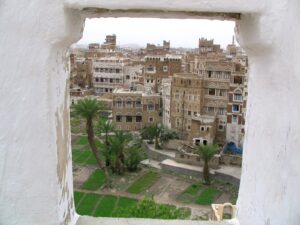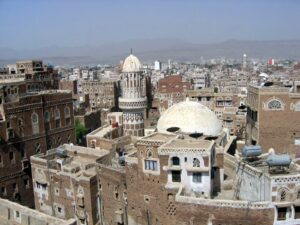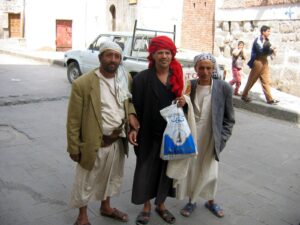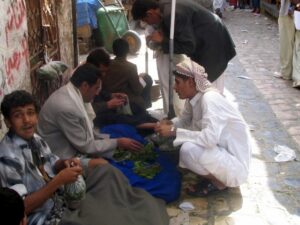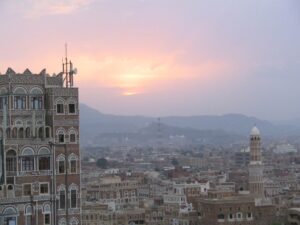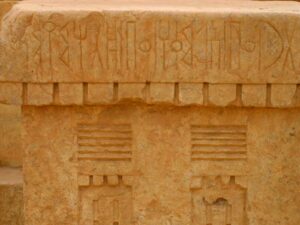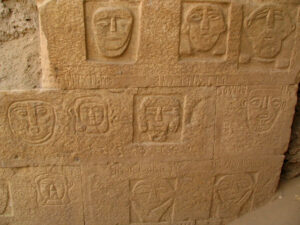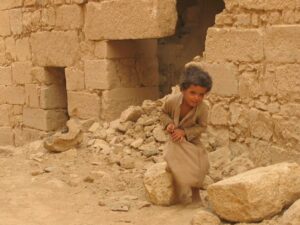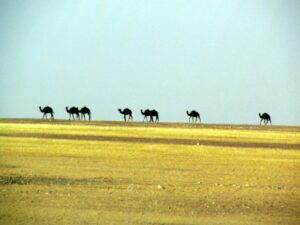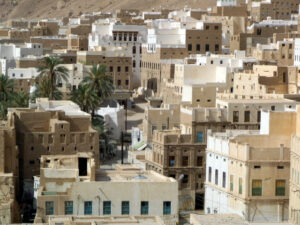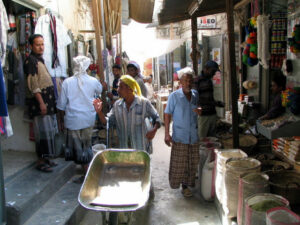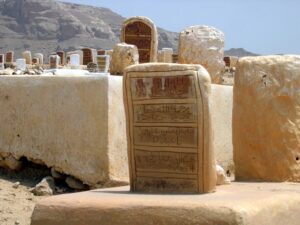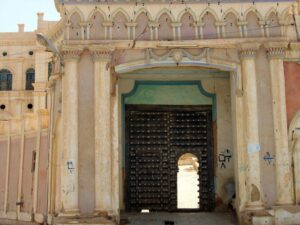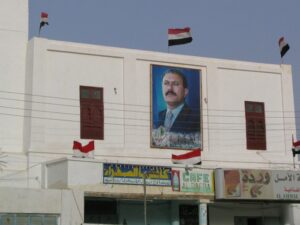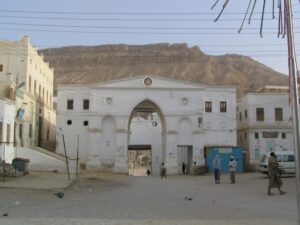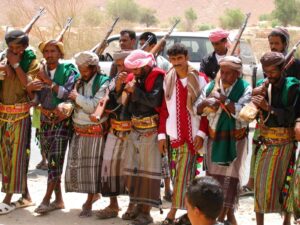Yemen is a country that has been luring us to explore its magical cities for years. We were rather reluctant after reading about the surge in kidnappings during the late 1990s. However, we actually met a young lady who was in Yemen in 1998, when the ill-fated UK-based jihad terrorists kidnapped an Explore tour group. Four members of that tour were killed during the Yemeni Government’s attempt to rescue them, and despite all that, she still claimed Yemen was one of the most beautiful countries she had ever visited, and stated that she longed to go back! Her description of Sana’a was mesmerizing, and her devout belief that 99.9% of Yemenis were extremely hospitable and inviting convinced us to give Yemen a whirl of our own. We are so glad we gave Yemen a chance…it truly is an amazing destination.
Our Yemen trip was hatched in May of 2005. We were surprised that our vacation request in July was approved, especially after our recent trip to Sri Lanka, but we had enough hours for a quick trip and were looking forward to a nice break from our work routine.
Becky did a comprehensive search on the Internet for various Yemen travel agencies, and after reading recommendations on the Lonely Planet Thorntree forum, decided on FTI Industries. Safwan did a remarkable job creating a budget custom tour for the both of us, which included the major highlights that we wanted to see (www.ftiyemen.com).
Flying in and out of Kabul International Airport (KIA) gets easier with each successive trip. This time, we were escorted to the front of the line since we had no check in bags. Our fee for this “special” service? $1 which was well worth the effort as who knows where our bags would have ended up if we were willing to check them in? There were competing flights to Iran and Delhi, and we doubted the airport staff’s competence to correctly route our bags to Dubai. So we happily lugged them on board the flight, and had no problems shoving them in the overhead compartments.
The Kam Air flight to Dubai was jam packed. No wonder Kam air bumped up their flight schedule from 4 days a week to 6 days a week. Foreigners were seated in the front of the plane, and Afghans were seated to the rear. Which suited us fine since some of our traveling companions were horridly smelly. This is not a slam on the Afghans, but it is a stereotype come true on our flight. Something about lack of water preventing regular showers. Whatever the reason, the Kam air staff duly took note and shuffled all the stinky travelers to the back of the plane.
Taking off was a scary experience. For the first time ever leaving KIA, our plane refused to rise. We reached the end of the runway, and it slowly (VERY SLOWLY) started liftoff, and we doubted we would clear the mountains surrounding Kabul. Our plane shuddered, and dipped up and down. Becky shouted her “I love you” goodbye chant, and everyone seemed intent on the power of prayer to get the damn plane to rise high enough. Miraculously, we did get up high enough, but the turbulence caused us even more consternation and white-knuckle gripping. After about 20 minutes, we knew we were safely on our way, and then the jokes started flowing in the front of the plane.
Our transit counter experience in Dubai was very painful. Note to anyone who flies via Dubai and has to deal with Terminal 2’s transit counter. The staff there is inadequate. Not only do they lack the training, but they are completely overwhelmed. The Afghans in line could speak no English, the airport staff could speak no Dari, and line-cutters of all nationalities were rampant. We stood in line to await our transit paperwork for the free shuttle to Terminal 1. We were third in line. About an hour later, we figured we’d cough up the extra dough, and catch a taxi to the main terminal. This was money well spent, even with the mandatory 20 Dirham airport surcharge fee! After storing our baggage in the storage area of the arrival section, we caught a taxi to the City Center Mall complex, where a dinner and a movie helped us kill some time. We spent the rest of our stay in Dubai at the airport lounge area, where we were able to elevate our feet for a night of restless sleep.
16 Jul: We boarded our Emirates Air flight from Dubai to Sana’a at 0600 in the morning. While waiting to load onto the plane, we met a Yemeni ex-tour guide who raved about our upcoming itinerary (he was lured in by the sight of Becky’s Lonely Planet Yemen guidebook). He did express serious reservations about our visit to Marib, which he claimed was the kidnapping capital of Yemen! He said that back when he was still a tour guide (late 1990s), it was impossible to visit Marib without an armed military escort. He explained the rationale behind the slew of kidnappings that occurred in Yemen since tourism opened up after 1990. The Yemeni tribal leaders wanted funding to build schools, roads, hospitals, and the like. The Yemeni Government was benefiting from the tribe’s oil rich reserves, and the tribal leaders wanted their fair share. Not able to negotiate anything satisfactory from the government, the tribal leaders resorted to kidnapping tourists, hence shaming the Government into paying the necessary ransom fee. Hundreds of tourists were used as pawns in this highly risky political game, which turned sour in 1998 when 4 tourists were killed as Yemeni commandoes stormed a hostage site in an effort to rescue over 20 tourists who were kidnapped from an Explore Worldwide tour. Of course his comments gave us great cause for concern, as our custom itinerary made no mention of an armed escort. Our newly found friend’s parting shot was “Insha-allah” (Trust be to God) that it would all work out!
Emirates Air is a really reliable and comfortable airline to fly with. In no time at all, we were about to land in Sana’a. We immediately hit the line for the entry visa. Robby took out Yemeni Rials, but we were relieved to find out that US dollars were also happily accepted. With only one person processing visa paperwork, it averaged about 5 minutes a tourist. We had absolutely no problems receiving a visa upon arrival, and were told that the Yemeni Government had eased restrictions on the Yemeni visa requirement. In fact, we did not even have to bring passport sized photos, nor medical certificates, which was contrary to the information we found posted on the Internet reference Yemeni entrance requirements. We met our Somalian tour guide, Abdul Kadir (pronounced “Ab-bah-dul”), and driver (Abdalla Kumaym) and they took us directly into the old city.
The airport is located only 15 minutes away, and the first thing we noticed was how calm this Middle Eastern capital city was. Unlike the hustle and bustle of Cairo, Beirut, or Damascus, Sana’a felt more laid back. Within a few short minutes, we were transformed into the magical city of Old Sana’a, where icy-white gypsum frosting decorated every building within sight. It was truly amazing. Our eyes yearned to soak the barrage of images that were before us. Sana’a is truly the Arab medina we had always imagined in our dreams. Men with jambiyas (curved dagger worn on a special belt) were at every corner, and women furtively hid behind their heavy black veils. Children ran amok throughout the street, and it simply felt like we were walking in history. We were sure that the images we saw played before us today had been played out for millennia, and we were just lucky enough to capture this same exact image during our lifetime.
Becky read that the Palace Hotels nestled deep inside the old city were a good lodging choice. Our tour guide initially recommend the fanciful Taj Sheba (5 * hotel), but we were looking for something a bit more authentic and real, and settled on the Taj Talha (2 *) which had an incredible location and phenomenal view from its Mafraj (top floor). We were given choice accommodations (room 601), which had a fantastic view of the city. The 360 panorama was absolutely unbelievable, and we spent hours taking photographs from the rooftop. Lunch wasn’t until 1300, so we had several hours to kill. Since we barely slept the night before, we decided to snooze for a bit. Robby still had a final exam to complete, so he broke out the computer and started working on his exam.
Lunch consisted of salta (the National Yemeni dish consisting of a thick, fiery, stew-like substance served boiling in a clay pot), chick-pea soup, chicken-fried rice, and sha’i (tea). It was absolutely delicious, in addition to being healthy! Abdul joined us in the middle of lunch, but he headed straight for the Qat room (yes, he was carrying his own bag of Qat). We declined the participation of the Qat session, but did partake in the sha’i. Tea in Yemen is served scalding hot, with a ton of sugar or mint leaves. We were engaged in conversation with a very articulate Yemeni girl named Doaa (“dough-a”), who wanted to practice her English on us. Half Egyptian, and half Yemen, she was absolutely gorgeous and felt no shame at uplifting her black veil in our company. It was a rare chance to interact with a Yemeni female, and we pelted her with numerous questions. Abdul finally decided to break up the party when he decided it was time for our sightseeing tour.
This afternoon, we wandered throughout the old town of Sana’a, and got lost within its maze-like corridors. We loved the experience, knowing that no matter how desperately lost we were, there was always a friendly soul to point us back in the right direction. Wandering through the Suq al-Milh was a trip. Have you ever wandered through a Jambiya souq? Rows and rows of daggers worn by Yemeni men lined the streets, and the vendors proudly posed for photos beside the fearsome creations. It is a weird feeling to see all men wearing the traditional jambiya, especially when you consider how easily they could slit your throat with it. But the men wear their jambiyas proudly, and every single one of them sauntered across the city streets with jambiya proudly in tow. Even young boys were dressed with mini-me jambiyas. You can easily see that the jambiya wearing tradition will not die down anytime soon!
Other souqs we visited included the Qat souq (where we were instantly offered Qat to suck on), the silver souq, and the ever-tantalizing spice souq. The Bab al Yemen is the best place to start one’s tour from. It is the busiest and most chaotic part of Old Sana’a. Little children would beg us to take their “sura” (picture), and when we did, shrieks of loud laughter pelted us as a reward. Tourists obviously revel in this area, and we were approached by numerous knick-knack vendors to buy a souvenir or two. Not interested? No hassle…it was absolutely wonderful to wander around freely without being approached by touts.
Everywhere we went, the locals would ask us where we were from. After “Amrika” brought about uncomfortable silence, we were urged by Abdul to say a European nation instead, so “Almaniya” (Germany) became our standard answer. Would you believe that the average Yemeni cannot tell the difference? But what a different response! Yemen has a constant flow of Spanish, Italian, or German visitors, so every time we said we were from Almaniya (which technically was true…we lived in Germany for over 7 years!), the locals would break out in super huge grins and give us a thumbs up, saying “Almaniya very good”. Our only worry was when we’d run into a Yemeni who spoke better German than us! Then our gig would be up for sure.
We loved wandering the streets of Old Sana’a, and Abdul left us on our own to explore further. Robby still had his exam to finish, so we wandered through the streets to find an Internet café where he could post his assignment. Maydan at-Tahrir was our best bet at finding access, and it was really cheap (1 hour for 100 Rials).
On our walk back towards the city center, the electricity in the old city went out. Instantly, the city was rejuvenated by candle light, which made for a more romantic stroll through the cobble stoned streets. Dinner was by candle light, followed by a moonlit glimpse over the city from the top of our mafraj. Once electricity was restored, a huge cheer erupted across the whole city, and wedding celebrations kept us awake until the wee hours of the morning. What a wonderful first day in the incredibly gorgeous Sana’a!
17 Jul: Woke up to the humming of the city. Morning prayers had already been called way too early (0400), and the city was moving at a frenetic pace by 0600. We packed, and headed downstairs for breakfast (really tasty breakfast rolls and hot tea), and linked up with Abdalah and Abdul for the start of our excursion outside of Sana’a. First stop: Marib, which was eerily known as the kidnapping capital of Yemen. The numerous checkpoints along the way confirmed this fact, with Abdalla having to provide our nationality and destination. At each check point, he gave them an official travel permit, which had all of our information listed (passport numbers, travel authorization). Abdul explained that if we were kidnapped, the Yemeni Government would know the approximate region (and hence the tribe) based on the last checkpoint that had cleared us through. At times, some of the guards tried to extort Abdalla for money or pens, but he simply roared out loud, and Abdul followed suit, shaming the guards into letting us pass unscathed. Those two were quite the characters, with both of them on the same sheet of music. If niceness didn’t pan out, then the ugly side of them erupted uncontrollably. The guards would actually cower in fear once they riled up Abdalla and made him roar in anger.
Everywhere we looked on the route from Sana’a to Marib, every Yemeni man lugged an AK-47 in addition to their Jambiya. We kept thinking of how easy it would be for them to point their guns at us and order us out of the jeep. But somehow, we made our way to Marib unscathed, and were there in time to take a morning breather before having lunch. We were set to explore Marib’s highlights that afternoon, but first it was time to relax and get out of the scorching July heat. We checked into the very comfortable Bilquis Hotel, where the AC was on full blast. Given the very hot morning we had experienced, this was a welcome relief in the middle of the day.
Marib is famous for being the legendary capital of the Kingdom of Sheba. Queen Sheba (whose name is really Bilqis) brings a powerful image of woman warrior who ruled a remote but influential corner of the world. Her story has long been touted by countless poets, movie directors, singers, and artists. According to our Lonely Planet guide, there are many Islamicized stories of Sheba, with the most famous one concerning Bilqis’ conversion to the faith of Solomon’s God (the forefather of Islam).
Marib is the most famous archeological site in Yemen. If a Yemeni hears you have been to Yemen, he or she will assume that Marib was part of the tour. (Its like visiting Paris without having seen the Eiffel tower). However, most Yemenis themselves have never been to see the sights of Marib! Lucky for us, Marib was on the tour, and the sights we were to discover today included the new dam, the surviving stonework of the original dam (which was world famous and allowed the city of Marib to prosper during the Kingdom of Sheba), the remains of the Temple of the Moon God (Awam Temple), the throne of Bilquis (Bar’an Temple).
The new dam was our first stop in Marib. It was built in the 1980’s by a donation from Sheikh Zayed bin Sultan al Nahyan, the ruler of Abu Dhabi (of the U.A.E.), at a tune of $75 Million. His lavish donation was to honor the fact that the Great Dam protected his forefathers, who lived near Marib before the disaster of 570 AD (the final destruction of the Great Dam). 400 Turkish workers built the new dam, under the management of a Swiss company, and today it truly is a sight to behold.
Several kilometers down the road lies the ruins of the Great Dam. The original ramparts on either end of the dam still exist, and it is almost inconceivable to imagine the size of the original dam. No wonder it was world famous during the reign of the Kingdom of Sheba as it was large enough to provide a water supply for hundred of thousands. Be sure to check out the inscriptions written on the remaining pieces of the Great Dam. There are inscriptions in both Sabaean and Himyarite. Several entrepreneurial Bedouins have decided to sell modern day “Sabaean inscriptions” on pieces of rock. We declined politely and the asking price kept dropping. Finally, in exasperation, we were offered the bargain price of $3, down for 30 Euros but we didn’t need another piece of rock decorating our humble abode so we decided to forego the special deal.
Our next stop was at the Mahram Bilqis. When we first arrived, it was locked up and the care-keeper was no where to be found. However, he soon came running and for a small donation, unlocked the gate for us so that we could peer in and see more than just the temple pillars. In fact, he showed us some amazing carvings (we think he was in love with Abdul…and who wouldn’t be? Abdul is a very handsome Somalian) and went all out to be a gracious tour guide. We read a little bit more about this site in our Lonely Planet guide book: In the early 1950s, American archaeologists uncovered most of the ruins that are now visible here. However, the local tribes became suspicious, and then downright hostile and closed down the excavation site. We definitely believe there is far more of Marib that remains to be discovered.
Second to last stop was the ‘arsh Bilqis (also known as the Temple of the Moon). Since tourism in Yemen isn’t fully fledged, the local care-takers have no idea what the going rate for an “entrance fee” should be. So random numbers are shouted out, and the response is eagerly awaited. Abdul wanted none of the shenanigans, and he roared out that he would not be extorted for money! He did agree to purchase sodas from the nearby store if we were let in for free. Such a shrewd businessman…we loved Abdul. The Temple of the Moon is nicely preserved, if a bit aesthetic.
We were eager to see history more in motion, and headed towards the ruined city of Marib. Much to our dismay, a huge sandstorm erupted without warning, and the gorgeous panoramas we had seen of Marib earlier that day had dissipated beneath the raging storm. First a brief detour to see how sesame oil is created. It really was quite funny to see the camels churning the sesame seed into a pulp. One camel walks about in a circle (with blinders over its eyes so that it won’t get distracted). A grown man adds his weight to the middle of the contraption for balance, and the camel walks around endlessly in circles. We had to take photos of this one for sure! The oil-maker was so proud to be in our photo that he stood up at attention, and inadvertently signaled his camel to press on, causing us to erupt in laughter at the comical scene.
The sandstorm kicked in really heavy as we made our way towards Marib. We were the only tourists there, but that didn’t stop the Bedouin women and children running up to us to ask for “Sura, Baksheesh”, which was their only way of making money! So we obliged by taking a photo or two of them amongst the ruins. The ruins of Marib truly are heart-wrenching. You could easily imagine what it looked like hundreds of years ago. Despite the merciless pelting of sand into our hair, eyes, and clothes, we spent quite a while wandering the ruins of Marib before finally retreating to the sanctuary of our hotel.
A thunder storm broke out that night as we were enjoying dinner. We sprinted back to our room, to escape the rain and fell asleep in anticipation of our early morning wake up for our jaunt through the Safer and Abr desert tomorrow.
18 Jul: 0400 is an ungodly wake up time, so we hit snooze and managed to squeeze an extra 30 minutes of sleep before finally rolling out of bed. With almost no baggage, it didn’t take us long to pack and load up the jeep. Surprisingly, breakfast was already awaiting us at this insanely early hour. We had to get an early move on for our trek through the desert as the midday sun would be relentless, and the desert was the most beautiful early in the morning. We were accompanied by Bedouin guides Ali and Mansoub, whom we quickly learned loved goofing around in the desert. To ensure that we had a safe passage, we first had to let out the pressure from our tires, so that they would have a sturdier grip on the desert sand. Afterwards, we took off like bats out of hell, and screeched our way across the desert, with our Bedouin guide veering in recklessly close to our jeep. At one point, we came across a high sand dune and decided to “ride” down it. We thought the vehicles were hopelessly stuck, but to our surprise, they easily navigated the steep decline down the dunes. The Bedouins laughed that it was a “desert rollercoaster”. Since their English was limited, we spoke in our limited Arabic and soon a healthy conversation ensued. Despite our guide’s dislike of American politics, he definitely wanted us to bring him an American bride on our next trip out there. We asked why she had to be American and he said American women were the best. Really crazy logic, but we all smiled and teased him that an American woman would not be happy with a nomadic lifestyle. Ah, have no fear…our Bedouin guide also owned a home in Marib, where she could live comfortable for about 6 months of the year (the other 6 months was out in the desert of course!)
We quickly convinced them we wanted a sura of us holding their AK-47s and dressed in traditional jambiya. Of course, they obliged and the ensuing photos are absolutely hilarious. They called Becky “Hani-baba” and Robby was “Ali-baba”. They really got a kick out of dressing up in their traditional gear, but wouldn’t let their weaponry out of their sights. A man surely knows to keep a close eye out on his survival tools!
The desert heat started scorching around noon, but we soon pulled back out of the Safer/Abr desert, and we back on blacktop. Our Bedouin guides would take us only as far as Hawra, before turning back around and hightailing it towards Marib. The reason we needed Bedouin guides to safely bring us across the desert was because without them, we would be at the mercy of other desert travelers. The Bedouins have an unspoken code of ethics that they would provide safe passage for all desert travelers. To contemplate negotiating a passage across without one of these guides was to ask for trouble (no guide=no guarantee of safe passage). As for us, we were more than happy to have Ali and Mansoub along for the ride, and were very interested in learning more about both of them. After lunch in Hawra, we had become so close to each other that kisses were shared all around, before a somber goodbye.
We made our way towards Seiyun, which would be our refuge that night. On the way, we caught a glimpse of the incredible Shibam, which really is unbelievable. Rising like a mirage out of the desert, Shibam is more eloquently known as the “Manhattan of the Desert”. The ancient city consists of 500 sky scrapers, each approximately 5 to 7 stories tall. All this crammed into an area of 5000 square meters! We were told that Shibam was an excellent example of ancient town planning, and were longing to explore Shibam during our more extensive tour tomorrow. As for now, we took several long distance shots, before hopping back into the jeep for our onward trek towards Seiyun.
The vistas along Wadi Hadramawt were unforgettable, and we both developed neck cranks from straining to catch everything as we zoomed on by. Never have we seen so many ancient mud-brick dwellings, in perfect harmony with the environment. Wadi Hadramawt is a very green and lush valley, whose inhabitants live in very picturesque surroundings.
We finally reached the outskirts of Seiyun, and pulled into the non-descript BMC hotel. From the outside, this hotel is nothing to rave about, but from the inside, it was the perfect oasis from our journey in the desert. We were given room 238 (incredible view over the oasis town from its windows!), and decided to relax for a bit before dinner. A quick jaunt into the BMC swimming pool was in order after our grungy, sandy, hot day and after a dip in the pool, all that dirt and grime just melted away. We relaxed by the pool side for hours until sunset, and then did a bit of laundry and freshening up before dinner. With the AC and fan on full blast, our clothes dried in a record breaking 60 minutes…the BMC was truly everything we needed out of a hotel: clean rooms, good food, and a comfy bed. We got caught up on the day’s news on CNN before calling it a day.
19 Jul: Today we were going to explore Seiyun, Aynat, Tarim, and Shibam. Quite an exciting itinerary and we fueled up for the day with an omelet, flat bread, and cheese. We love simple breakfasts, and this simple but tasty one did the trick. At 0800, we linked up with Abdul and Abdalla and were on our way towards Seiyun. Seiyun was the former capital of the Kathiri Sultanate, and one of the best legacies is the Sultan al-Kathiri Palace, which is entirely built of clay and brick (decorated with gypsum). We were told that since Seiyun prospered greatly as a major player along the caravan route, it was more commonly referred to as the “town of a million palm trees”. We believe it, as the palms today produce some of the world’s finest dates. (Becky wanted to be sure to rave to her mom that she was able to buy 1 KG or 2.2 lbs for a mere 100 Rials, which equates to 60 cents! Can anyone find a better deal than that? These dates were out of this world sweet…we wish we had bought more!)
The Sultan’s palace in Seiyun offers really spectacular views over the city of Seiyun and its many beautiful mosques, minarets, and tombs. The exhibits on the ground floor are OK, but the photograph collections on the second and third floor are unforgettable. Intrepid travelers from the 1930s recorded much of Yemen (which amazingly, has changed very little from the Yemen of today!). After taking hundreds of photos from the roof of the palace, we decided to wander through the souq. There, we witnessed our first robbery in Yemen. The thief thought that the novelty of tourists (us) would cause a sufficient distraction for him to make off with some food. However, all he succeeded in accomplishing was an ass-beating by every local in the souq! Seriously, we saw multiple indignant men shove and beat this poor guy around, before unceremoniously pushing him back out onto the main street and hurling insults loud enough so that the commotion caught the attention of passersby. This thief was not going to be forgotten by anyone anytime soon!
The village of Aynat was next on our stop. This small but serene village is famous for its religious tombs and shrines. Since there was no gate-keeper, we were able to wander just inside the perimeter to sneak a couple of shots and examine the Arabic-inscriptions on the tombstones. Wherever there are tourists, children have an uncanny ability to sense it, and we were soon surrounded by children asking for a pen. It must be effective, because children everywhere constantly ask for pens, but if we were to oblige each and every one of them, we literally would have given out hundreds if not thousands of pens by now!
Last stop before lunch was to Tarim, which is famous for its Javanese-baroque palaces (23 of them), as well as being the center for Shafa’i school for Sunni Islamic learning. We made our way towards the Al-Kaf Palace (also known as the Tarim Museum), where we could easily see the old splendor of this mud-built palace, but were saddened to see its current state of disrepair. All it would need is a little TLC to get back into its original shape, which would have been marvelous back in its heyday. Afterwards, we wandered down to the suq, where the camera-shy vendors refused to be photographed. Note: always honor those who decline to be photographed. We read that rude tourists who insisted on snapping away soon found their cameras snatched out of their hands and smashed on the ground! And to be honest, we could definitely imagine that scenario as some folks were downright hostile at the glimpse of our cameras! The Islamic tradition actually prohibits the making of portraits, so taking photographs of people in Yemen is a tricky subject. We always made sure to ask first…while most people would love to pose for us, there were many who did not to. It’s really no big deal…just ask “mumkin sura” (it is possible to take a photo) and if a broad smile appears, no problem. If not, just walk away…very simple!
Wandering the streets of Tarim, we met two British – Islam converts, who were students at the Shafa’i school. They seemed to be VERY devout in their conversion, briefly giving us a background on why Tarim was such a holy ground (Good thing Becky was dressed from head to toe and covered in a scarf!). They were both friendly enough but extremely fanatical. In light of last week’s London subway bombings, we knew that anyone who visited these “pro-terrorists” countries in the future would be under huge scrutiny (us for example?), which is really sad because they really seemed happy to be devoutly studying Islam in a pro-Islam nation. But we can imagine the troubles they would face upon returning back to England after a year abroad studying Islam in Yemen! They invited us to visit the library with them (many incredible Islamic manuscripts), but Abdul reappeared, and seemed very distraught that others were talking to his guests, so he rudely and brusquely blew them off and urged us on to lunch.
After a delicious but simple lunch of chicken, we headed back to the BMC for some rest and relaxation, before our afternoon excursion to Shibam. We went back out at 1530, and wandered the muddy, dusty streets of old Shibam. UNESCO has donated $40M in reconstruction efforts, which was in dire need after the floods of 1982, 1989, and 1998. Shibam is definitely an experience that you must go through personally. The goats and sheep that crowd the bottom floor of the multi-story houses is reminiscent of Biblical scenes. Simple mud-covered high rise flats, children playing in the dusty streets, and very quaint windows are visible every inch of Shibam. Shibam is worth the extra effort in getting there…we were very glad that we were able to visit this magical city.
After exploring to our heart’s content, we wandered over to the Southern side of the wadi, and climbed up the top of the cliffs of the new suburb of Sihayl. This position gave us a wonderful view of the sunset over Shibam…absolutely brilliant. From our high vantage point, we had a birds eye view over Shibam, and could watch as dust storms blew in periodically. The boys playing soccer just played through the debilitating dust storms, which left us hacking and gasping for air in between teary eyes, but they simply laughed at our patheticness and played on. We really had a new found respect for Yemeni ruggedness after watching them cope with the desert’s harshness.
Dinner was late that evening back at the BMC and we ordered lamb. Spent the late evening listening to drifts of Arabic praying/singing by an older imam and young boy as their melodic voices floated into our room from the neighboring oasis village.
20 Jul: Today we would make our way towards Mukalla. Little had we realized but our trip’s itinerary would change dramatically this afternoon due to some controversial governmental policies that had occurred late last night in Sana’a. Gas prices have been subsidized by the Yemen government, and a liter of gas can be purchased for a mere 35 Rials (something like 15 cents or so). The Yemen government had recently assumed a new change in subsidization, and gas prices soared overnight from 35 Rials to 700 Rials! (More on par with the expensive European gas prices…something like $3.50 a liter…outrageous) It was such an astronomical change, and with no forewarning, that the people were in a murderous rage and wanted immediate retaliation. Therefore, a bounty on all travelers making their way through Bedouin tribal areas was announced, and it was very unsafe for us to travel through remote regions, as we could be seized and used as bait into further negotiations with the government.
Of all this, we were blissfully unaware as we made our way from Seiyun towards Mukalla. We later found out that over 18 people were killed in the Sana’a area, as they raged against the government in this terribly-timed announcement. All western buildings (such as Pizza hut) were targeted and destroyed. While we were unaware of the brewing turmoil about us, we were having a marvelous time exploring the Wadi Hadramawt area.
In fact, our attention was focused on capturing a remote image of the nakhl-wearing women working the fields. The nakhl is a witch-style conical straw hat (with a hole at the very tip top to allow for cool ventilation), and the women wearing them were clad from head to toe in heavy black cloth. We wondered how they could see as their eye-slits were barely big enough (and some of them had no eye slits but simply had to peer through the cloth!) Tourists have been charmed by these unique women for years, and the women have resorted to stoning any tourists within arms reach! Therefore, we used Becky’s 10x optical zoom to the max, and would never take a photo unless we were about at least 100 to 200 meters away…safely out of a stone thrower’s reach, unless she happened to have a very strong and accurate arm! We called the women the “Hadramawt Witches” and were definitely bewitched by them.
First stop was at Al-Mashhad, where we were able to peek in and see the Tomb of Hasan ibn Hasan from 1591 (rebuilt in 1830s). This small, sleepy oasis town was quite picturesque, and it probably took the local souvenir vendor about 15 seconds to spot us and make his sales pitch. Amazing that no matter where in the world you go, there is always someone up to making a buck or two! Next stop was the very picturesque Al-Hajarain, which is one of the most ancient and beautiful villages in the area. The name of the town actually means “two cliffs” or “two stones”, and we could admire the two separate towns clinging to the sides of their respective cliffs. Our quick hike to Al-Hajarain brought immediate demands by kids for a “qalam” (pen). However, they happily settled for a candy instead. Vehicular transport up the hill is limited, so we laughed at the locals’ method of coping…the donkey. This sturdy beast lugged heavy luggage up and down the hillside and had free reign at the top of Hajarain!
The views from Wadi Daw’an are among the prettiest of Wadi Hadramawt. We were lucky enough to be a witness to a wedding ceremony, which was taking place right by the side of the road. Upon asking if it was OK to take photos, we were immediately enthralled by the colorful futas (cotton clothes that the men wear as wrap-around skirts), and their display of weaponry. Since we were uphill from them, once we realized that they were aiming in our general direction for the finale of the ceremony, we came sprinting back downhill and were safely out of the stray bullets’ path! The bullets ricocheting into the mountain side was VERY loud. We were really lucky to have come across the wedding ceremony, and were more than happy to take individual’s suras when they asked us to. We can certainly attest that the AK-47s the locals lug around are in good working condition and not just for looks!
We stopped to take photos of the Wadi and admired the fantastic views overlooking the valley. Afterwards, we had a quick pit stop lunch along the way, with of course, our favorite meal: lamb. Some words of caution about ordering lamb in Yemen. You will get all the bits and pieces of lamb meat…intestines, stomach, bones, and choice pieces of meat. It’s a hodge podge serving of lamb, and you take it all in one go. We ate in a relaxed setting, with Becky being the only woman present. The men were lounging comfortable on the ground, taking in their daily round of Qat (khat). Their leafy green balls of Qat would cause some green dribble down their chins, and we were truly amazed at how much qat can be stuffed into one’s mouth. Of course, qat was offered to us, but we were reluctant to try it, after having read how nasty the first taste is. (Qat is definitely an acquired taste from what we read).
When we started our descent from the Wadi towards Mukalla, we instantly felt the heat wave rising. By the time we reached sea level, we were sweating profusely. What a difference the elevation makes! We made a quick stop at Husn al-Ghuwayzi, a tiny fortress atop a small cliff just outside of Mukalla. It was built in 1884 as a toll booth, and has come to symbolize the city itself. Shortly after that, we pulled in and checked into the Rayboon City hotel. We were immediately contacted by the president of the FYI Tour company (he spoke excellent English having worked in Great Britain for a while) who explained that our safety could not be guaranteed if we were to continue along with our original itinerary (via the coastal road towards Bir Ali, inland at Wadi Mayfa’a, towards Al-Rawda, overnight in Al-Baydha before continuing up North via Rada’a, Dhamar and ultimately Sana’a. Instead, he recommended we cool our heels in Mukalla (the Southerners were apparently not as riled up as those up North), and he would arrange for a last minute flight from Mukalla towards Sana’a the day after next. This gave us plenty of time to explore the coastal city of Mukalla, but for tonight, we were urged to lay low and only roam during daylight hours. So we obliged and spent the evening eating delectable hummus (Becky’s favorite dish) and lamb.
21 Jul: We had a late morning start since our formal tour didn’t kick off till 0900. But sunlight poured into our room at 0500, and we were restless. We linked up with Abdul and Abdalla after breakfast and heard that 18 people were killed during yesterday’s riots in Sana’a area due to the gas fiasco. What a nightmare! We have no idea if that means we will be able to continue on with our Northern excursions around Sana’a, and have to wait patiently to see how it all plays out.
We started off our day exploring Mukalla’s corniche and old town area. All the buildings are built with blue doors or shutters and white-washed. But the town has grown at an astronomical rate, and gone are the romantic harbor-front views of yesteryear. Instead, we are faced with a busy, bustling corniche skyline of modern looking souqs, mosques, and apartment buildings. The locals gathered on one end of the corniche to watch each other as they built up the nerve to dive into the cool water. We took mid-air photos and showed them to our delighted divers. Afterwards, we wandered the souq area, where Becky bought a Hadramawt-style futa (garish neon green, yellow, and pink), before picking up another kilo of dates…yummy, our favorite!
We still had plenty of time to kill, so to beat the midday heat, we went back to the hotel, grabbed our swimsuits, and headed over towards the Holiday Inn to use their beach area services. The Holiday Inn Mukalla is easily the most posh hotel in Mukalla. AC instantly blasted us as we strolled through the lobby and down towards the pool. Becky was the only female on the beach in a swim suit (can you believe the local women were still covered head to toe in black heavy cloth and they would only dip their toes into the water to cool down?). Instead, we jumped into the ocean and were shocked to find out that the sea-water was freezing! We expected warm waters due to the summer heat wave, but were surprised at the sudden drop in temperature.
Lunch was at a local fish restaurant, which was packed to the brim. Apparently, this restaurant had rave reviews among the locals, who flocked its tables and filled it to max capacity. We followed suit, and ordered grilled fish (samak) and fresh bread (khubz). Absolutely delicious meal…definitely order the fish if you are ever in Mukalla. Abdalla pointed out another local favorite dive to get great seafood, and we tucked away both places to memory in case we ever return here in the future.
Abdul had friends in Makalla and we decided to set him and Abdalla free in case they wanted to venture about the city. As for us, an afternoon siesta to beat the heat was in order, and we were anxious to return to Sana’a on our morning flight tomorrow.
22 Jul: We were sitting next to a man who was nosily slurping goat’s brains for breakfast. Trying not to eyeball his meal too conspicuously, we concentrated on ours, which consisted of a simple breakfast of flat khubz and fasuliya (beans)…it sounds simple but it was absolutely delicious!
This morning, we were all set for our flight back to Sana’a from Mukalla’s domestic terminal. As the influx of foreign travelers at the airport revealed, everyone else’s holiday plans were ruined as well because of the rioting ongoing within Yemen. We wished Abdalla a safe journey back to Sana’a and promised to see him in a few days. He reversed his route back to Sana’a (through Wadi Daw’an, Wadi Hadramawt, towards Marib, and then Sana’a). As we later chillingly found out, Abdalla had quite an adventure returning back to the capital. With the locals still in a rage over the hike in gas prices, he was driving a “marked” vehicle (with tourist bumper stickers giving him away). While he was in Marib, some Bedouin shot at him, with the bullet ricocheting off the front bumper. He sped on through, and managed to return back to Sana’a relatively unscathed, but we could just envision the problems we would have faced if we were to continue on with our original tour itinerary.
Checking in at the domestic terminal was relatively simple, but time consuming. Later on we realized that we were still waiting for our plane to land, so once we heard its engines roaring in the distance, everyone eagerly stood in line waiting to board. It was a packed flight, with over 30 tourists who were in the same dilemma as us.
Upon our arrival in cooler Sana’a, we were advised to stay inside the Taj Talha hotel, where we decided to have a quick lunch. After lunch, we decided to head up to the mafraj, where we had an excellent view of the old city getting pelted by the afternoon rain storm. There is something amazing about the sight of old Sana’a getting drenched by the rain; everything appeared clearer and more crisp. Of course, it made for a muddy and very wet venture when we finally made our way outdoors! There were two Americans from Princeton who were in Sana’a for a summer of intensive Arabic that were also hanging out at the mafraj. Once the Spanish group joined us, it made for a very tight and cramped “hang-out” spot, so we ended up leaving and walking the soaked streets of Sana’a.
During our afternoon excursion in the old city, we inevitably got completely lost and disorientated. Which is the whole purpose of sightseeing in Sana’a! We stumbled upon a lot of interesting sights we otherwise wouldn’t have, had we not been hopelessly lost. After a while, we could tell we were definitely walking in circles around Sana’a, as we kept bumping into throngs of children clamoring for us to take their photos. Once we saw the same grubby outfit twice, we knew we had been down that street already! In one of the alleyways, we were immediately surrounded by hyper kids demanding we take a photo of them. They let out squeals of laughter after each photo was taken, and we probably would have stayed there longer, had not one of the boys who was wielding his Jambiya not started to swing it in a menacing way to shoo away the girls from the camera. He wanted his very own picture for himself, but we left because we were really afraid that he would either hurt himself or one of the throngs of girls beckoning us to take a photo of them. The rest of our time was spent meandering through the many markets and suqs. After the city had long gone dark, we finally found our way back to the hotel after successfully navigating our way through hours of misadventure in the maze of Sana’a.
23 Jul: We linked up with Abdul early this morning for a half-day tour of old Sana’a. Our quest for today? To find an Arabic learning center (either CALES or SIAL) so we could check out the facilities, get a bird’s eye view from Bab al Yemen, and enjoy a session of khat chewing with the locals from our hotel.
We were horrified to learn of the atrocities committed in Sharm el-Sheik on this morning’s CNN. Bombs had been set of in the popular Egyptian tourist town, and we learned that the body count was still growing (over 80 dead and hundreds wounded). The staff was also visibly upset, as they mentioned that whatever happens in the Middle East has a ripple effect for all countries. Even though Yemen is a safe distance away, tourists would associate all the bad news in Lebanon and Egypt with Yemen and start canceling their tours. We found out later that they were correct. A large Italian tour group that Abdul was supposed to guide decided to opt out of their tour! Meanwhile, we were left to ponder the randomness of it all. What the hell is the world coming to? What are the objectives of these sick minded people whose primary goal is to inflict as much pain and suffering on innocent people? With three separate bombings in Sharm, Beirut, and London, where on earth would be considered “safe”? We just don’t comprehend the rationale behind these attacks, and apparently, neither do the Yemenis who were watching the TV as astounded as we were.
We were really impressed with CALES (Center for Arabic Language and Eastern Studies), which was conveniently located in the middle of Old Sana’a. There were 40 students (5 Americans) who had good facilities and a clean environment in which to study. Plus the cost was amazing! We grabbed brochures so we could ponder over them while we decided between which city we would study Arabic in (Cairo, Damascus, or Sana’a).
After lunch, we spent the rest of the day hanging out with everyone else in the khat-chewing room. We drank tea, and chatted endlessly about random stuff. Doaa joined us, and we had a chance to show her our website and fill her mind with options of different countries to visit. Chewing qat has no visible effect on the participants. We had read that it would make you sleepy or mellow, but the hotel staff did it every day and therefore, the effect on them was negligible.
Our biggest accomplishment for the day was the purchase of the world’s most famous silver coin. We browsed several antique stores until we happened upon several authentic silver Maria Theresa thalers, which have been minted intermittently since 1780. The thalers have been so prevalent in the Middle East as the 1780 was the only silver coin the Arabs trusted and would accept. “The taler became the unofficial currency of some of the lands in North Africa, and it can still be found today in many Arabian bazaars”. We sure did find some, and were happy to bring home unique pieces of history.
We were getting itchy feet for having been on lockdown for essentially 2 days, but what felt like a lifetime. We watched Seinfeld to keep our minds off the gas-situation, but were very restless in anticipation of our tour tomorrow. We vowed we would escape to the outskirts of Sana’a come hell or high water!
24 Jul: This morning’s argument was quickly resolved by a phone call to Safwan. We were very disappointed to hear that due to the on-going police road blocks, our route to Shibam and Kawkaban was to be cancelled. So we proposed several other changes to the itinerary, including a visit to Ar Rawda’s Sunday market as well as a side trip to Bayt Baws (literally translated to “House of Baws”). Safwan readily agreed, and it was settled. We understood where Abdul was coming from, he just wanted to ensure our safety, but we were tired of being stuck in Sana’a and longed to explore more of its outskirts.
First stop was to Bayt Baws, which is a mountain top village located near Sana’a. This scenic village offers broad views overlooking the countryside, and as soon as we arrived, the children offered us cactus pears for breakfast. We wandered through the ruins of the village, and were surprised to learn that the government initiative to provide the local villagers water backfired. Since they were accustomed to drawing their water supply from the local cistern, they spurned the new water pumps that the government installed. Instead, many of them moved elsewhere, and we saw only a handful of families still occupying the area. The mountain top village stank of the rotten of animal dung and urine. But the old stone houses and walls were in surprisingly good shape and offered us the hint of what the village used to look like centuries ago. A girl herder guided her sheep through the alleyways, and the scene reminded us of what life must have been like in the past.
Dar al-Hajar was the next stop on our itinerary, and boy, it does not disappoint! We can now easily see why the Rock Palace graces the cover of every Yemen tour book…it truly is beautiful. The 5 story palace now functions as a museum, and we enjoyed climbing inside it to wonder at the fantastic 360 degree panorama views offered on the roof. The palace was originally built in the 1930s by Imam Yahya as a summer residence, but we were so glad that it has been converted into a museum. Probably one of Yemen’s best tourist cards, and they have played it well. The palace was packed with over a dozen tourists who, like us, were forced to stay within the tight confines of Sana’a and its very close surroundings.
Safwan called us to let us know that the police were allowing a limited number of foreigners to travel the outskirts of Sana’a. Therefore, our afternoon excursion to Thula, Kawkaban, and Shibam was a go! We were really happy to hear this sudden change in plans, and our day’s prospects brightened up considerably.
Thula (or Thilla) is a fortress town with its original walls. It is a prime example of the Arab’s magnificent use of stone masonry, as almost all of the original building material is still intact. We drove about 50 KM to get there, and the moment of truth came at our first checkpoint. The guards jotted down all of our details, but did grant us access to pass. We were happy they did, as Thula is a magnificent city to visit. The aqueducts, cisterns, mosques, and old Suq were wonderfully preserved. Thula is also the site of the most intensive/aggressive souvenir peddlers! The children of Thula speak multiple languages (German, English, French, Spanish, and Japanese) in order to sell silver jewelry or scarves. We couldn’t resist their charms and made a few small purchases. After enjoying Thula, our next stop was a brief one at Hababah, which had the most amazing cistern of all the ancient cities we visited while in Yemen.
Our lunch stop was had at the Kawkaban Hotel in Kawkaban, which offered a bird’s eye view on the neighboring Shibam (not the other, more famous Shibam). Kawkaban is famous for showcasing the Yemeni passion for building villages on high, inaccessible mountaintops. It is also a great place to bird-watch. We enjoyed the view overlooking Shibam, and were soon joined by some Scandinavians who were equally impressed with the vistas.
Shibam was the last stop of the day. There actually is a really funny story about Shibam, which was recorded as a tale in “The Thousand and One Nights”. Here is the story:
A man fouls up his wedding ceremony by letting out a tumultuous fart at the peak of the festivity. In utmost shame, the man flees the scene, riding his horse all the way to India and finally settling there. Years later, he decides to put an end to his exile and returns home to Yemen. On the outskirts of his adored village, he dismounts by a house and happens to overhear a conversation through a window. A young girl asks her mother about her age and is told that she was born ‘on the day of Husayn’s historic fart’. Facing the horror of the fact that his fart will never be forgotten or forgiven, the man mounts his horse and rides away, this time forever
The Jabal Kawkaban towers over the village of Shibam, and when we squinted, we could still make out the Scandinavian group at the top. We wandered through the rustic town of Shibam in relative peace, as the village folk were more concerned with the arrival of the propane gas supply. They were hustling towards the center of town to receive their new propane gas tanks, and turn in their old ones.
We returned to Sana’a late that afternoon, and had some free time to wander through the old streets of Sana’a one last time. We were really sad to be leaving, but happy to know that one day we would be back for the dual purpose of studying Arabic, as well as taking in more of this marvelous country.
25 Jul: Met Doaa for breakfast and promised to mail her some photos upon our return. It was really wonderful befriending a truly open and independent Yemeni woman. For us, it was a relief to realize that despite the restrictive look of the black cloth that drapes so many of the women here in Yemen, it actually allowed them greater independence and freedom. Very ironic, but here was a young woman of 22, who had the world by its balls. She was nearing the completion of her master’s degree, was dreaming of her doctorate, and was fluent in many languages. We were certain that her scholarship abroad to Germany would be a life changing event, and truly wished her well.
Abdul and Abdalla were awaiting us at the entrance to the Taj Talha hotel, and within minutes, we had the airport in our sights. Checking in at the Emirates counter was a breeze; the funniest part was when the x-ray technician demanded $5 from us to “screen” our bags. We just laughed out loud, and were allowed to pass through unscathed. Does anyone fall for that scam? I supposed that the timid or easily intimidated would allow themselves to be bullied around, but as for us, we simply knew better. I suppose it goes back to the age-old comment we heard while we were back in Egypt. The men there were explaining why foreign women were continually subjected to come-ons. They told us that for every 10 women they asked to sleep with them, at least 1 would say yes. While we doubted the authenticity of this statement, it did explain the rationale of folks asking the absurd, in the remote chance that someone might actually give in!
While we were sad to be heading back home towards Kabul via Dubai, we were ready to get back to a sense of normalcy and routine. So long beautiful Yemen! We long to return so that an in-depth intensive Arabic course can be taken for about a year…hopefully within the next few years we will be ready to embark on that adventure.







